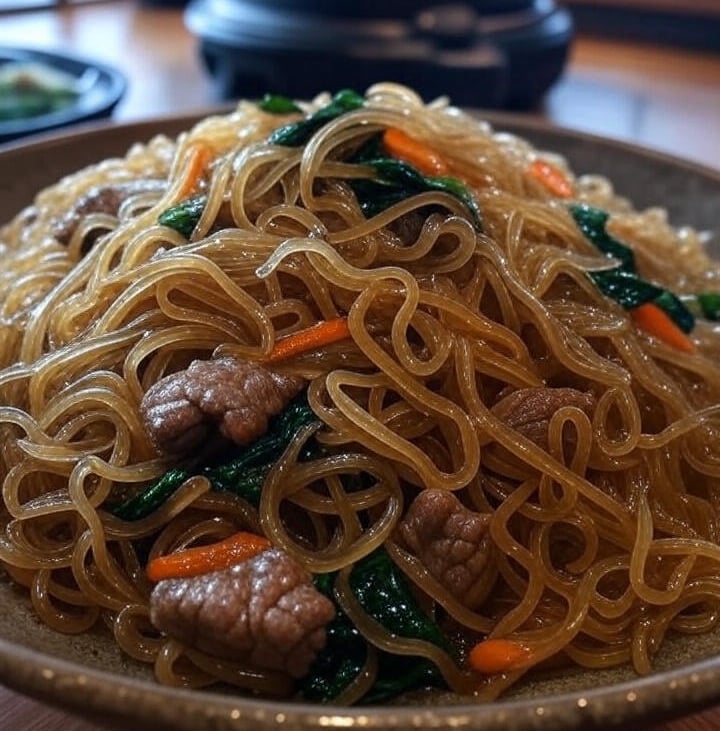Welcome to Noodles of Asia ! - A Woke Noodle Blog
Delighting in Japchae Noodles: A Journey Through Korea’s Sweet Potato Treasure


Hey there, noodle enthusiasts! If you've ever enjoyed a colorful plate of glossy, chewy noodles mixed with veggies and meat, you’ve likely tasted japchae. These sweet potato starch noodles, known as dangmyeon, are a cherished dish in Korean cuisine, loved for their tender texture and savory-sweet flavor. Whether served as a side or main course, japchae brings festive joy to any meal. In this post, we’ll explore their origins, history, some fascinating facts, and a few famous recipes to inspire your next culinary adventure. Let’s dive in!
Origins and History of Japchae Noodles
Japchae, meaning "mixed vegetables" in Korean, originated during the Joseon Dynasty (1392–1897), created for a royal banquet by a court chef. Initially made without noodles, it evolved in the 17th century with the addition of sweet potato starch noodles, reflecting Korea’s agricultural abundance. The dish gained popularity as a celebratory food, especially for holidays like Chuseok, and spread beyond palaces to households. By the 20th century, Korean immigration introduced japchae globally, adapting it into a beloved fusion dish.
Interesting Facts About Japchae Noodles
Japchae noodles aren’t just food—they’re a cultural celebration! Here are some intriguing tidbits:
Regional Variations Galore: From Seoul’s classic japchae with beef to vegetarian versions in Buddhist temples, and modern twists with seafood, each style shines.
Noodle-Making Craft: Traditionally, japchae noodles are made from sweet potato starch, boiled, and stir-fried with soy sauce and sesame oil, giving them a glossy finish.
Festive Appeal: A staple at Korean gatherings, japchae symbolizes harmony with its colorful ingredients like carrots, spinach, and mushrooms.
Global Fusion: In the West, japchae inspires dishes like japchae tacos or paired with global spices, showcasing its adaptability.
Historical Roots: Early Korean records mention vegetable mixes, with noodles added later, linking japchae to royal culinary heritage.
These facts highlight japchae’s journey from a royal dish to a global favorite.
Famous Japchae Noodle Recipes
Japchae’s charm lies in its versatility. Here are some iconic recipes, from traditional classics to creative twists. (Note: These are overviews—adjust to taste and check full recipes online for details.)
Classic Japchae: Stir-fried sweet potato noodles with beef, spinach, carrots, and soy sauce—a balanced delight.
Vegetarian Japchae: Noodles with mushrooms, bell peppers, and sesame oil—a plant-based joy.
Seafood Japchae: Noodles with shrimp, squid, and veggies in a light soy glaze—coastal flair.
Spicy Japchae: Noodles tossed with gochujang sauce, beef, and onions—a fiery twist.
Chicken Japchae: Noodles with marinated chicken, zucchini, and mushrooms—a hearty option.
Japchae Salad: Cold noodles with cucumber, sesame, and a tangy dressing—a refreshing take.
For a hands-on challenge, try making japchae at home: Boil sweet potato noodles, stir-fry with veggies and protein, and season with soy sauce—or use pre-made noodles for ease.
Wrapping It Up
Japchae noodles are more than just food—they’re a connection from ancient Korean royal traditions to modern global kitchens, with endless variations to explore. Whether you’re craving a colorful plate on a cool evening or a festive dish for a gathering, japchae delivers. Next time you’re at a Korean restaurant or in your kitchen, give one of these recipes a try. What’s your favorite japchae style? Share in the comments—I’d love to hear! Until next time, happy slurping! 🍜
